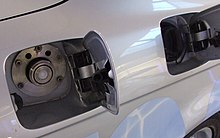Bivalent (engine)
This article includes a list of general references, but it lacks sufficient corresponding inline citations. (August 2012) |

A bivalent engine is an engine that can use two different types of fuel. Examples are
Types
Alcohol and Petroleum
Engines that can use either alcohol (often produced as a
Compressed or Liquefied Natural Gas and Petroleum
Compressed natural gas (CNG) is made by compressing
Liquefied Petroleum Gas and Petroleum
Hydrogen and Petroleum
Bivalent engines can also use hydrogen fuel, as demonstrated by the BMW Hydrogen 7 using a bivalent V12 H7 Series engine. The engine itself is similar to a regular gasoline combustion engine, except for the fuel injection system. When a BMW Hydrogen 7 is running in gasoline mode, the fuel is injected directly into the cylinders, but when the vehicle is running on hydrogen, the fuel is injected into the intake manifold. BMW claims the Hydrogen 7 is the "world's first production-ready hydrogen vehicle", although only 100 total vehicles have been produced, and no more are planned to be produced.[4]
Future
Reduction of greenhouse gas emissions and preservation of natural resources are becoming increasingly important to people around the world. Many countries have regulations on the fuel economy of newly manufactured vehicles, and many governments offer tax breaks for vehicle manufacturers that use clean-burning fuels. Vehicle manufacturers are thus motivated to develop new internal combustion engine technologies. The bivalent engine allows for an easier transition from fossil fuels to alternative fuels. The technology is advancing and there is increasing demand for more efficient and cleaner burning engines.
Hydrogen fuel
Gaseous Hydrogen
Hydrogen is being researched as a fuel for vehicles because it produces no carbon dioxide emissions. If hydrogen fuel becomes more popular, it has the potential to be less expensive than other fuels, if low-cost production via electrolysis can be implemented.[citation needed] Hydrogen can be used and created in fuel cells to power electric motors or burnt directly in combustion engines. BMW has developed a bivalent internal combustion engine that can switch between petroleum and liquid hydrogen fuels. In gaseous form, hydrogen is difficult to store and has a low volumetric energy density. It can be produced in many different ways, but many of the methods produce carbon dioxide. The most promising method is electrolysis. Safety of the hydrogen storage tanks in the event of an accident has been investigated, and various tests show that they do not present any problems.[5] When used as a fuel, hydrogen has a wide range of flammability and low ignition energy. These properties allow hydrogen to be burned using a wide range of air-fuel mixtures, but problems arise with premature ignition. Crankcase ventilation is very important when burning hydrogen, because of the low ignition energy. Proper ventilation is needed to prevent ignition in the crankcase and the formation of water in the engine oil.[6] Hydrogen and natural gas are very similar fuels, so the differences between the components needed to burn them are trivial, and interoperable systems are easily made.
Liquid Hydrogen
The volumetric energy density can be increased if hydrogen is stored as a cryogenic liquid. Liquid hydrogen provides almost a third as much energy per unit volume as gasoline.
Liquid hydrogen fuel has some disadvantages. The technology is very new and the infrastructure for liquid hydrogen filling stations is currently very limited. Many of the processes commonly used in creating the fuel give off
See also
- Flexible-fuel vehicle
- Hybrid vehicle
- CleanEnergy
- Natural gas vehicle
References
- ^ "Clean Alternative Fuels: Compressed Natural Gas" (PDF). United States Environmental Protection Agency. Archived from the original (PDF) on 11 February 2012. Retrieved 15 January 2013.
- ^ "LPG and natural gas". Next Green Car. Retrieved 15 January 2013.
- ^ Liquefied Petroleum Gas (LPG)
- ^ "BMW EfficientDynamics : BMW CleanEnergy : BMW AG". Archived from the original on 2011-09-23. Retrieved 2016-07-28.
- ^ "BMW: Hydrogen and Clean Energy Strategy". Carlist.com. Archived from the original on 15 August 2013. Retrieved 15 January 2013.
- ^ "Hydrogen Use in Internal Combustion Engines" (PDF). College of the Desert. Archived from the original (PDF) on 3 October 2012. Retrieved 15 January 2013.
